Weekend Herb Blogging: Methi
Methi, also known in English as fenugreek greens, is a lovely plant.
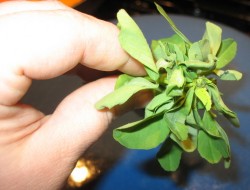
It has delicate ovoid leaves of a nice medium bluish green, dainty triangular flowers and grows in a mounding habit.
A legume, meaning it is of the same family of nitrogen-fixing plants as peas, beans, clovers, alfalfas and locust trees, methi has deliciously fragrant, slightly bitter leaves when fresh; when dried, these same leaves have the amazing scent of newly-mown hay. In fact, the English name, “fenugreek” comes from the Latin species name, foenum graecum, which means, “Greek hay.” This name comes from its use as an animal fodder in the ancient Mediiterranean region.
The leaves and thin stems can be used fresh as a vegetable or an herb in Indian cookery, depending on how much of it the cook uses. It is delicious cooked as spinach, but the flavor is much more assertive than the much more unassuming spinach. Used dried, the hay-scented leaves (sold as kasouri methi) are wonderful flavorings either for potatoes or dal, both of which benefit from being cooked with the fresh leaves as well.
The dried seeds are used toasted and ground in many masala mixtures, and iin many Western curry powders. In fact, when Americans ask what spice is it that “smells like curry powder” I always tell them it is fenugreek, and when they smell it alone, I am almost always right. To most American and British palates who grew up eating curry powder, fenugreek is what makes curry taste and smell like curry.
Some Americans object to the smell of it; particularly considering that it seems to get into the body and seep a bit from the skin’s pores. This does not bother me. Fenugreek seeds are naturally somewhat antibacterial, and I like their earthy smell. After having ramps get into my skin from the inside out, I can only say that methi is a great improvement!
Aloo methi was my first experience with methi leaves. I ate the dish at Akbar’s in Columbia, Maryland, and it was a great surprise. They made it with dried leaves, and the flavor was addicting. Zak and I ate all of it, and he is not even that fond of fried potatoes. But these he loved, and could not get enough of them. Vowing to learn to make the dish, I scoured the local Indian markets for methi, and was thrilled to find large bouquets of them fresh.
Snatching it up, I cooked it with potatoes and was sad to find that the flavor was good, but different. Fresh methi and kasouri methi carry two different aromas and flavors, I soon discovered, and so over the years, as I developed my aloo methi recipe, I changed it so that it uses methi in three different forms: fresh, dried and as toasted, ground seeds.
This results in a dish that is very intense with subtle layers of flavoring from the three very different versions of the same herb.
The amount of ginger and chiles is variable to one’s taste, but I always use a geat deal of deeply browned onions in the dish. While boiled, peeled and cubed potatoes are traditional, I like to boil whole fingerling potatoes in their jackets and then cut them into chunks, skin still on. Fingerling potatoes have a creamy texture that when boiled and then fried turns into a crispy outer coat, concealing a meltingly velvet interior.
Aloo methi, however, is not the only dish that benefits from the addition of fresh and dried methi leaves. I am also exceedingly fond of dal tarka methi–a dal that has been flavored with a tarka of browned onions, garlic, chiles, mustard seeds, cumin seeds and a saute of fresh methi leaves. To add my characteristic “triple punch” of methi flavor, I also add a couple of tablespoonds of the dried herb to the lentils and beans as they cook, as well as using toasted ground seeds in the masala mixture that goes in at the beginning of the cooking process.
Methi is an herb that is well worth seeking out, particularly if one cooks a great deal of Indian food. It is good added to the spinach in palak paneer, it is good cooked in a mixture of greens in saag aloo and it is really very good in any dal. I am told that it is good with chicken, as well, but I have to admit to liking it so much with potatoes and dal, I have not tried it cooked with chicken yet. (Besides, curry leaves and chicken are a magical combination–one that I will highlight next week on my second venture into Weekend Herb Blogging.
But for now, to celebrate my first entry into Kalyn’s Weekend Herb Blogging event, I present not one, but two recipes featuring methi in three forms: my fingerling potato aloo methi and my dal tarka methi which is made of a combination of masoor dal–pink lentils, and split moong dal–split moong beans. (I like the combination of the two dals into one dish because masoor dal cooks into a smooth puree, which gives the dish body, while the moong beans keep their distinct shape as they cook, giving textural contrast.)
The aloo are good with roti, while I like the dal with steamed basmati for breakfast or lunch. Or dinner–it is one of my favorite foods. The dal is particularly nice with cucumber-tomato raita in the summer, too.
Aloo Methi
Ingredients:
1 teaspoon cumin seeds
1/2 teaspoon black peppercorns
1 tablespoon coriander seeds
1/2 teaspoon fenugreek seeds
2 cloves
1 teaspoon turmeric
4 tablespoons peanut oil
1 medium sized onion, thinly sliced
1/2 teaspoon salt
1″X2 1/2″ cube fresh ginger, peeled and julienned
3-6 red thai bird chiles, thinly sliced on the diagonal (to taste)
2 tablespoons dried methi leaves, soaked in water until rehydrated, then drained with the excess water squeezed out
2 teaspoons cumin seeds
1 1/2 teaspoons mustard seeds
1 pound fingerling potatoes, scrubbed well, boiled and then drained and cut into 3/4″ chunks
1 large bunch fenugreek greens, large stems discarded, washed well, drained dry and chopped roughly
salt to taste
Method:
Toast the first five ingredients in a small, heavy bottomed pan over medium heat until lightly browned and fragrant. Remove from pan, allow to cool, then grind into a powder. Add turmeric powder, and set aside.
Heat oil in a wok or heavy-bottomed skillet until it smokes. Add onion, and sprinkle with salt. Cook, stirring constantly, until onion is golden brown. Add ginger and chiles, and whole spices. Add soaked methi leaves. Continue cooking, stirring constantly, until onion is deep brown.
Add potatoes, and cook, stirring until the cut edges are browned, and everything is quite fragrant. Add fresh methi, and cook, tossing and stirring, until the leaves just wilt.
Salt to taste.
(Note: you can add a squeeze of lime or lemon juice to this dish for a new, tangy version.)
Dal Tarka Methi
Ingredients:
1 1/2 cups masoor dal
3/4 cup split moong dal
water as needed
1 bay leaf
1 big pinch asafoetida
2 tablespoons minced fresh ginger
1 tablespoon coriander seeds
1/4 teaspoon cardamom seeds
1/2 teaspoon fenugreek seeds
1/2 teaspoon black peppercorns
3 cloves
1 teaspoon turmeric
1 teaspoon paprika (all I had was smoked Spanish paprika, and it added a non-traditional, but delicious flavor)
1 can diced tomatoes (14 ounces), juice drained (I used Muir Glen Fire Roasted tomatoes)
2 tablespoons dried methi leaves
2 tablespoons butter or ghee
1 small onion, thinly sliced
3-5 red thai bird chiles, thinly sliced
3 cloves garlic, peeled and thinly sliced
1/2 tablespoon cumin seeds
1/2 tablespoon mustard seeds
1/2 large bunch fresh methi leaves, prepared as for aloo methi
salt to taste
Method:
Sort through dals, and discard any twigs, bits of rock, dirt or weird looking beans. Rinse well, and drain. Put into a medium sized heavy bottomed pot with enough water to cover by 1″. Add bay leaf, ginger and asafoetida. (It is said that these three will help prevent flatulence. I don’t know about that, but they do make the dal taste good–and really–the more dal you eat, the more accustomed to digesting it your body becomes.)
Bring to a boil, turn down heat and simmer.
Toast the coriander, cardamom, fenugreek and peppercorns as directed above, then grind. Add to the dal along with the turmeric and paprika. When the masoor dal has broken down, and the moong beans are just tender, add tomatoes and dried methi, and then cover pot, and turn heat off. Allow to sit, cooking in its own heat while you cook the tarka.
Heat butter or ghee in a heavy-bottomed pan, and cook onions until they are dark golden brown. Add chiles, garlic, cumin seeds and mustard seeds. Cook until onions are dark reddish and everything is very, very fragrant. Add methi greens, and cook until wilted.
Pour tarka into pot of dal, clap the lid back on, stir, turn heat back on, bring to a simmer. Bring lid up just a bit to taste–add salt as needed, and put lid back on.
Bring to the table, and lift the lid before family or guests and allow the steam from the tarka carry the delicious flavors to their noses.
32 Comments
RSS feed for comments on this post.
Sorry, the comment form is closed at this time.
Powered by WordPress. Graphics by Zak Kramer.
Design update by Daniel Trout.
Entries and comments feeds.

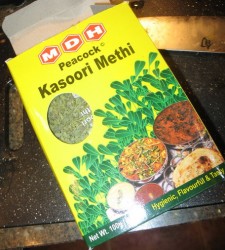
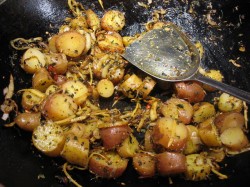
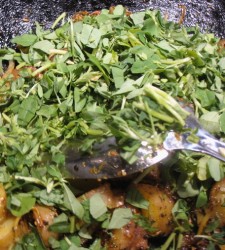
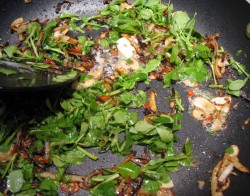
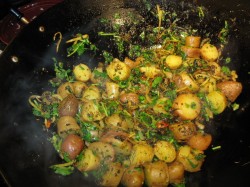
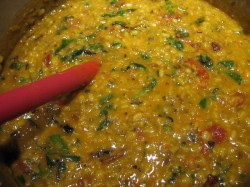


What a wonderful post. I’m impressed with your knowledge. I do love fenugreek, but haven’t seen the plant before.
Comment by Kalyn — February 19, 2006 #
You can pick up the greens fresh or dried at Indian markets, Kalyn. It is apparently easy to grow, as well. I will have to give it a shot in the summer when we put our garden in.
Comment by Barbara — February 19, 2006 #
Thank you so much for this information! I just saw Methi at my local grocery store this past week, and had no clue what it is or what it was used for. Now that I know I will have to pick some up and play with it.
Comment by Erika — February 19, 2006 #
You know. THe only time I’ve seen fenugreek was at the health food store. I was instructed to take it as a supplement when I first had my child because it apparently helps milk production—and boy did it!
I’ll have to look for it as a cooking item now! Thank you for the information. 🙂
Comment by Sarah — February 20, 2006 #
Erika, it is truly a worthy addition to the spice cabinet. Thus far, I have tended to only use it in an Indian context, along with Indian spices, but I think that it could be used to enhance any cuisine.
I am thinking of using it in scrambled eggs, for example. Or a fritatta! Ooh. Yeah, that is a good idea.
Sarah–Unfortunately, I learned about fenugreek’s milk-enhancing properties after my breastfeeding days were over, but I also remember hearing that it affected the flavor of the milk as well. (Garlic does, too–which may be why my Morganna, when she was a toddler, was so passionate about garlic. Hrm….)
Not that it would be a bad thing–it is just something I remember reading. And knowing how the scent of fenugreek seeds gets into my pores–it is probably true.
But then, I like smelling like fenugreek, so it is all good.
Comment by Barbara — February 20, 2006 #
I love fresh methi but am not wild about fenugreek seeds. (Last winter, we discovered the wonders of fenugreek tea for helping us get through bad colds. But is sure does taste awful!!! And I’m afraid I’m not wild about the smell either.)
We’ll have to look for dried fenugreek leaves. I feel sure they are readily available!
Your aloo methi and dahl dishes look really good, Barbara.
-Elizabeth
Comment by ejm — February 20, 2006 #
You did a wonderful job.my drools over your pictures.Congrats
Comment by ramya — February 21, 2006 #
oops!my tongue drools simply over the picture.
Please excuse my typing in earlier comment.
Comment by ramya — February 21, 2006 #
Love the look of the aloo methi, and how nice to see lesser-known/used herbs in the spotlight!
🙂
Comment by KW — February 22, 2006 #
Elizabeth–fenugreek seed tea has too overpowering of a taste and smell on its own. In my recipes where I use it–you will note I use only a tiny amount of it. It enhances the curries immeasurably, yet doesn’t take over. If you use too much, or use it on its own–it is very, very strong.
Ramya–welcome! Thank you for visiting, and I have no issues with your typing. I knew what you meant!
Thanks, KW–next Saturday, I will talk about curry leaves–another less well known herb here in the US, at least. It is quite well known in India, as is methi.
I wonder if curry plants are easy to grow?
Comment by Barbara — February 22, 2006 #
Curry plants are decently easy to grow. My mother grows curry leaves in her family room for cooking, though she supplements this supply with leaves from friends. When my sister and I were kids some ten to twenty years ago, it was hard to find these leaves even in Indian grocery stores, so my mother’s friend would sell it from her flourishing plant. We kids used to call it the illegal karuveppilai trade, heh.
Comment by Aparnaa — February 22, 2006 #
I am pretty sure I can get my hands on curry plants at Companion Plants here in Athens. They carry every herb known to humankind, nearabout.
I will have to try raising one, then–thank you Aparnaa.
Comment by Barbara — February 23, 2006 #
I’m afraid even the smallest amount of fenugreek seed in a curry is pretty stinky to me. Granted, the flavour it adds is lovely but the smell does linger forever. Fenugreek leaves are a whole other story though.
Because of your post about aloo methi, my husband made aloo methi this week (I was going to post this morning about it in my blog but my host is doing some upgrading I cannot access my site.) And it was fabulous! Aloo methi is definitely a keeper. Thank you, Barbara!
-Elizabeth
Comment by ejm — February 25, 2006 #
Great post and the choice of Indian recipes using methi is absolutely wonderful.
Comment by Sailaja — February 25, 2006 #
[…] Methi is quite pretty – small oval shaped darkish green leaves. Alas, we didn’t take a photo of the methi before we cooked it. But Barbara did and you can see what fenugreek leaves look like on her post about aloo methi. You can also see her recipe for aloo methi there. […]
Pingback by blog from OUR kitchen » aloo methi... we adore good food — February 28, 2006 #
Hi there! The Aloo Mehti is making me drool on my keyboard. I want to make it with a couple of Cornish Game Hens I bought…I like my chicken simple, but as I do not cook Indian flavors often…what seasonings would you recommend for the hens so they are complimenatry. I am going to attempt Nann possibly, but i will cheat and buy a mix in Little India. 🙂
Comment by Tatyanna — March 19, 2006 #
Cornish game hens? Mmm. Let’s see. Mash up a couple of cloves of garlic and a 1/2″ piece of fresh ginger into a paste. Mix a little salt in, and grind up about a quarter teaspoon of black peppercorns, 1/8 teaspoon cardamom seeds, 1 tsp. coriander seeds, two whole cloves, and a pinch of powdered cinnamon. Add the zest of half an average sized lemon, and two tablespoons of butter. Add the juice of 1/2 the lemon as well, and mash all of this up into a compound butter. Loosen the skins of the little birds, and stuff this butter mixture under the skins. Inside the cavities, cut up the other half the lemon into chunks and put them in. Rub the outside of the skin with a teaspoon of butter, and then salt and pepper it generously and roast as usual.
That should go nicely with the potatoes.
Comment by Barbara — March 19, 2006 #
Hi Barbara,
Thanks for the delicious recipes made out of methi.
I like your interest in Indian food.
When you are using mustard seeds in your recipe…. it is good to first add mustard seeds to oil, heated on a medium flame and let them pop before adding onions. This is typical Indian way of cooking.
When you allow mustard seeds too crack you would get a nice aroma and you can also avoid any possible unpleasant taste caused by uncooked mustard seeds.
Take care not be around the pan because mustard seeds pop in all directions just like pop corn.
Hope you like my comments.
Comment by RR — June 3, 2006 #
[…] Methi was a foreign vegetable for me until I started to blog. Foreign in the sense that I have never tasted it. This wasn't available in Kerala when I was growing up, and even when I was in Delhi, I never ventured to try it. But most Indian food blogs and many non- Indian bloggers featured this veggie, and I had to try it. And of course, I loved it. […]
Pingback by Salt and Pepper. » Blog Archive » Green Blog Project - Fish with baby methi (fenugreek) leaves — June 8, 2006 #
Even after being an Indian, I didn’t have this experience of cooking methi aloo in such an authentic indian way. I learned and enjoyed the cooked one after following directions given by you. Thank you very much.
Comment by Rashi — June 30, 2006 #
Rashi–I am very, very glad you liked my recipe for aloo methi! I learned to make it by tasting and experimenting–and I really like the combination of fresh and dried methi greens and the methi seeds. It gives a very good, savory flavor to the potatoes that is hard to beat. I have never served this dish to anyone and have them dislike it.
Though, interestingly, the scent of methi gets into your blood when you cook it like this–I noticed that for days afterwards, my husband’s skin smelled of the sweet mown hay scent of methi–as did my own.
It is like being annointed with perfume from the inside!
Thank you for commenting, and I hope that you go on to use methi many other ways now that you have tried it once.
Comment by Barbara — June 30, 2006 #
What a great recipe! I’m a new mother, and I recently discovered fenugreek seed is a wonder at increasing breastmilk production. I started wondering if you could just *eat* a lot of the stuff, rather than taking fenugreek caplets, to get a similar effect. I’ve found that you can! And this recipe will be one I make frequently when I’m nursing, and even after.
Comment by Rebecca — August 8, 2006 #
Rebecca–you can also make tea from dried fenugreek greens and seeds, too, and drnk that. Some people don’t like the taste, but I think it is allright. It kind of tastes the way alfalfa hay smells–probably because the two plants are related. You can always sweeten it with honey to help make it more appealing as well.
I’ll be joining you in the new mother/breastfeeding phase soon–my second child is due October 29th. Look for more fenugreek recipes after that!
Comment by Barbara — August 8, 2006 #
hi there Methi’s lovers, not only aloo methi you can add these leafs to Masala chicken in which it taste so goooooood. try it and enjoy it.
Comment by Paramdeep Singhq — December 20, 2006 #
Your Aloo-Methi is one of the best I have read about. I just cooked the dish today using your recipe and loved it.
Jagadish
Comment by Jagadish — February 25, 2007 #
I have to rediscover some Indian cooking with absolute low fat, low salt…how do you suggest I modify these recepes to accommodate my situation? I just had open heart surgery: so converting to Dean Ornish diet of low fat/ zero cholesterol…any other ideas of cooking dals/legumes?
thnx
PS: I have my own curry leaf plant!
Comment by bougnoul — November 8, 2007 #
I would switch from butter/ghee to canola or sunflower oil, and use up two 2/3 less of it in each recipe.
For dals. instead of tarka, I would oven roast onions and garlic and add that, and dry roast the spices. See if that works.
Comment by Barbara — November 8, 2007 #
fenugreek seeds soaked in water for 6 hrs to 24 hrs and consumed can reduce blood pressure. worked in me. try it.
Comment by vivek — November 19, 2007 #
Just came back from a Hindu healer and she suggested I take Methi, Coriander, spinish or cabbage and mint leaves liquidize it with a little bit of boiled water and drink the juice – a wonderfull way the clean your system.
Comment by Mari — March 13, 2010 #
[…] will also note that I served a dry version of aloo methi with this meal. Some of the versions of aloo methi are damper than others–aloo methi tamatar […]
Pingback by Tigers & Strawberries » Meatless Monday: Channa Bhatura — December 13, 2010 #
[…] Can Try at Home Urban Dictionary: native indonesian9 Quick Remedies That Treat Hair Loss Tigers & Strawberries #viralMultiplier_Banner { display: block; position: fixed; top: 0px; left: 0px; width: 100%; […]
Pingback by Please help: Looking for Chinese and Indian herbs (& herbalist) in Indonesia? | Herbs For Health — October 31, 2011 #
[…] a break and buy fresh herbs: cilantro, parsley, methi, and curry leaves (if you can find them). Also buy some pre-made breads so you can quit worrying. […]
Pingback by no counterspace » Blog Archive » Planning for City Kitties — March 7, 2012 #